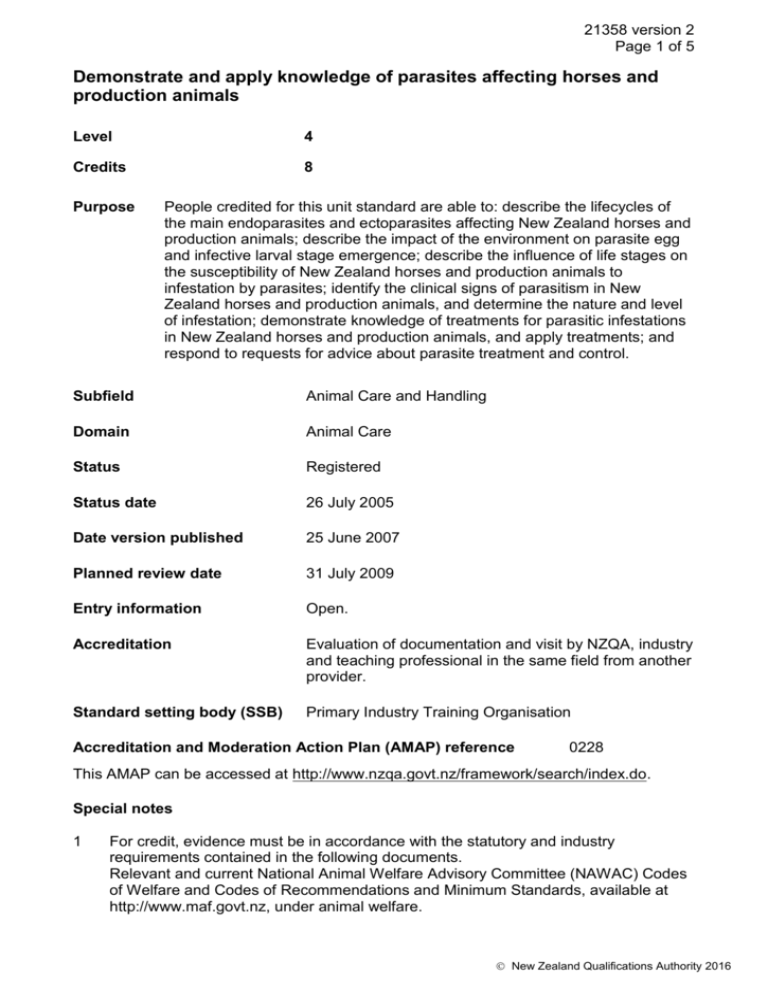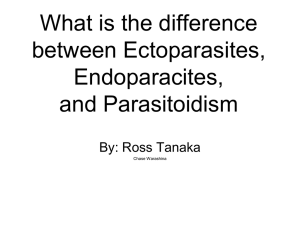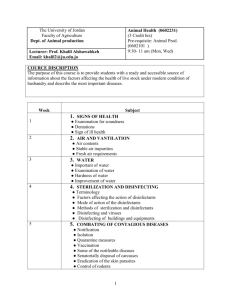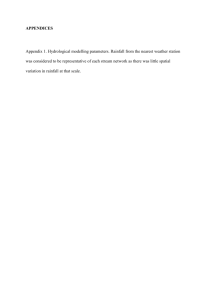53KB - NZQA
advertisement

21358 version 2 Page 1 of 5 Demonstrate and apply knowledge of parasites affecting horses and production animals Level 4 Credits 8 Purpose People credited for this unit standard are able to: describe the lifecycles of the main endoparasites and ectoparasites affecting New Zealand horses and production animals; describe the impact of the environment on parasite egg and infective larval stage emergence; describe the influence of life stages on the susceptibility of New Zealand horses and production animals to infestation by parasites; identify the clinical signs of parasitism in New Zealand horses and production animals, and determine the nature and level of infestation; demonstrate knowledge of treatments for parasitic infestations in New Zealand horses and production animals, and apply treatments; and respond to requests for advice about parasite treatment and control. Subfield Animal Care and Handling Domain Animal Care Status Registered Status date 26 July 2005 Date version published 25 June 2007 Planned review date 31 July 2009 Entry information Open. Accreditation Evaluation of documentation and visit by NZQA, industry and teaching professional in the same field from another provider. Standard setting body (SSB) Primary Industry Training Organisation Accreditation and Moderation Action Plan (AMAP) reference 0228 This AMAP can be accessed at http://www.nzqa.govt.nz/framework/search/index.do. Special notes 1 For credit, evidence must be in accordance with the statutory and industry requirements contained in the following documents. Relevant and current National Animal Welfare Advisory Committee (NAWAC) Codes of Welfare and Codes of Recommendations and Minimum Standards, available at http://www.maf.govt.nz, under animal welfare. New Zealand Qualifications Authority 2016 21358 version 2 Page 2 of 5 Relevant New Zealand Veterinary Association (NZVA) standards, available from NZVA, PO Box 11-212, Manners Street, Wellington (http://www.vets.org.nz) including the current versions of Standard Procedures for Veterinary Nursing and Animal Care (referred to in this unit standard as standard procedures); BESTPRACTICE™ Standards for Companion Animal and Large Animal Combined Module for Mixed Practices; and BESTPRACTICE™ Standards for Large Animal Practice Module. New Zealand Standard NZS 4304:2002 Management of Healthcare Waste. Animal Welfare Act 1999, Health and Safety in Employment Act 1992, and any subsequent amendments. 2 Although not a prerequisite, Unit 21355, Collect and test diagnostic samples from large animals, and prepare the samples for dispatch, contains useful underpinning knowledge for this unit standard. 3 Definitions In-house procedures refer to the documented policies and procedures for animal care, handling, and ethical behaviour codes required by the employer, consistent with NZVA BESTPRACTICE™ standards. Production animals, in this unit standard, refers to all ruminant species, pigs, and poultry. Elements and performance criteria Element 1 Describe the lifecycles of the main endoparasites and ectoparasites affecting New Zealand horses and production animals. Performance criteria 1.1 Parasites affecting ruminants are described in terms of their lifecycle. Range 1.2 Parasites affecting horses are described in terms of their lifecycle. Range 1.3 endoparasites include but are not limited to – Parascaris equorum, Dictyocaulus, Non-migratory strongyloids, Migratory strongyloids, Cyathostomes, Anoplocephala perfoliata, Gastrophilus equorum. Parasites affecting pigs are described in terms of their lifecycle. Range 1.4 endoparasites include but are not limited to – Haemonchus, Nematodirus, Ostertagia, Trichostrongylus, Taenia ovis, Dictyocaulus, liver fluke. endoparasites include but are not limited to – Oesophagostomum, Stephanurus dentatus, Ancyclostomas, Metastrongylus, Trichinella, Hyostrongylus, Ascaris suum. Parasites affecting poultry are described in terms of their lifecycle. Range endoparasites include but are not limited to – Coccidia, Ascaridia galli, Capillaria, Histomonas meleagridis. New Zealand Qualifications Authority 2016 21358 version 2 Page 3 of 5 1.5 Ectoparasites affecting horses and production animals are described in terms of their lifecycle. Range includes but is not limited to – mites, lice (biting and sucking), fleas, ticks, flies, keds. Element 2 Describe the impact of the environment on parasite egg and infective larval stage emergence. Performance criteria 2.1 Egg survival, and larval survival and emergence, are described in terms of the influence of temperature, humidity, rainfall, irrigation, and other external conditions. 2.2 Pasture contamination by eggs and larvae is described in terms of pasture management and stocking rate. Element 3 Describe the influence of life stages on the susceptibility of New Zealand horses and production animals to infestation by parasites. Range includes but is not limited to – pregnant animals, lactating animals, juvenile animals, dry stock. Performance criteria 3.1 Changes to animals’ susceptibility to infestation by parasites during each life stage is described in terms of their nutritional requirements and immune system. Element 4 Identify the clinical signs of parasitism in New Zealand horses and production animals, and determine the nature and level of infestation. Performance criteria 4.1 Clinical parasitism is identified according to its signs. Range 4.2 may include but is not limited to – pot belly, dull coat, licking, scouring, hair loss, weight loss, depression, anorexia, evidence of parasitic organisms. Nature and level of endoparasite infestation is determined using procedures outlined in standard procedures. New Zealand Qualifications Authority 2016 21358 version 2 Page 4 of 5 Range 4.3 External parasites are identified. Range 4.4 procedures include but are not limited to – direct smear, tape impression, faecal flotation, faecal sedimentation, faecal egg count (McMaster’s technique). includes but is not limited to – mites, lice, fleas, ticks, flies and keds. Nature and level of ectoparasite infestation is determined using procedures outlined in standard procedures. Range procedures include but are not limited to – coat and skin examination, microscopic examination of hair samples, tape impression, skin scraping. Element 5 Demonstrate knowledge of treatments for parasitic infestations in New Zealand horses and production animals, and apply treatments. Performance criteria 5.1 The main drench families are described in terms of their mode of action and effectiveness against groups of parasites. Range 5.2 The main insecticide families are described in terms of their mode of action and effectiveness against groups of parasites. Range 5.3 includes but is not limited to – dose rate, weight of animals, timing of treatment, pasture, feed intake, genetics, frequency of drenching, dosing technique. Anthelmintics and/or insecticides are applied according to the manufacturers’ instructions. Range 5.5 organophosphates, synthetic pyrethroids, insect growth regulators. Anthelmintic resistance is explained in terms of its causes. Range 5.4 includes but is not limited to – Benzimidazole, Levamisole, Avermectin/Milbemycin, Praziquantel, any combinations of the former drugs. methods of application include but are not limited to – oral liquid, pour on, injection, oral capsule. Post-treatment level of parasitic infestation is determined by the Faecal Egg Count Reduction Test. Element 6 New Zealand Qualifications Authority 2016 21358 version 2 Page 5 of 5 Respond to requests for advice about parasite treatment and control. Performance criteria 6.1 General inquiries are assessed to determine the most suitable person to deal with them. 6.2 Advice given on endoparasites and ectoparasites is provided clearly and courteously, is accurate, and is within own capability and according to in-house procedures. Range 6.3 advice may include but is not limited to information on – lifecycles of common parasites affecting production animals and horses in New Zealand, environmental influences on parasite incidence, factors affecting susceptibility of animals to parasitic infestation, signs of parasite infestation, effective anthelmintic and insecticide use, economic impact of parasitic infestation. Specialist sources of information about parasites are identified and accessed for information. Range sources may include but are not limited to – other veterinarians outside own practice, product distributors and manufacturers. Please note Providers must be accredited by NZQA, or an inter-institutional body with delegated authority for quality assurance, before they can report credits from assessment against unit standards or deliver courses of study leading to that assessment. Industry Training Organisations must be accredited by NZQA before they can register credits from assessment against unit standards. Accredited providers and Industry Training Organisations assessing against unit standards must engage with the moderation system that applies to those standards. Accreditation requirements and an outline of the moderation system that applies to this standard are outlined in the Accreditation and Moderation Action Plan (AMAP). The AMAP also includes useful information about special requirements for organisations wishing to develop education and training programmes, such as minimum qualifications for tutors and assessors, and special resource requirements. Comments on this unit standard Please contact the Primary Industry Training Organisation standards@primaryito.ac.nz if you wish to suggest changes to the content of this unit standard. New Zealand Qualifications Authority 2016







